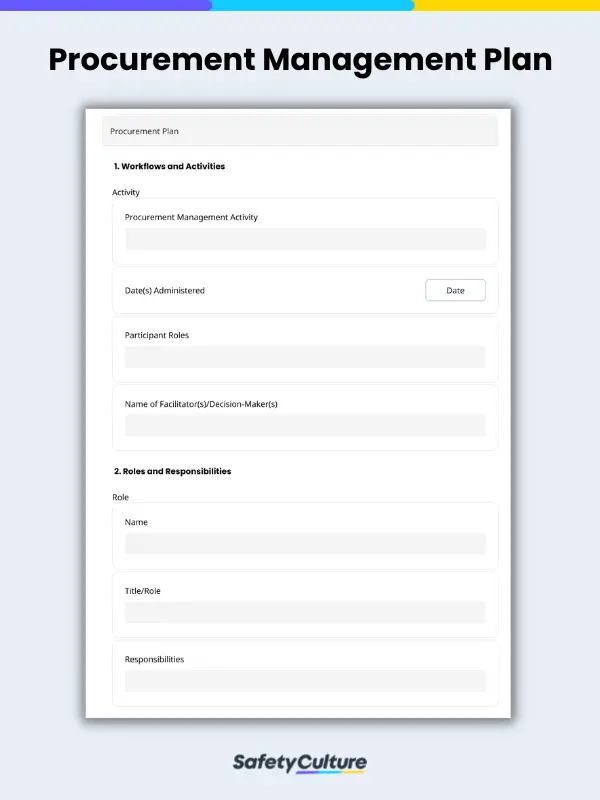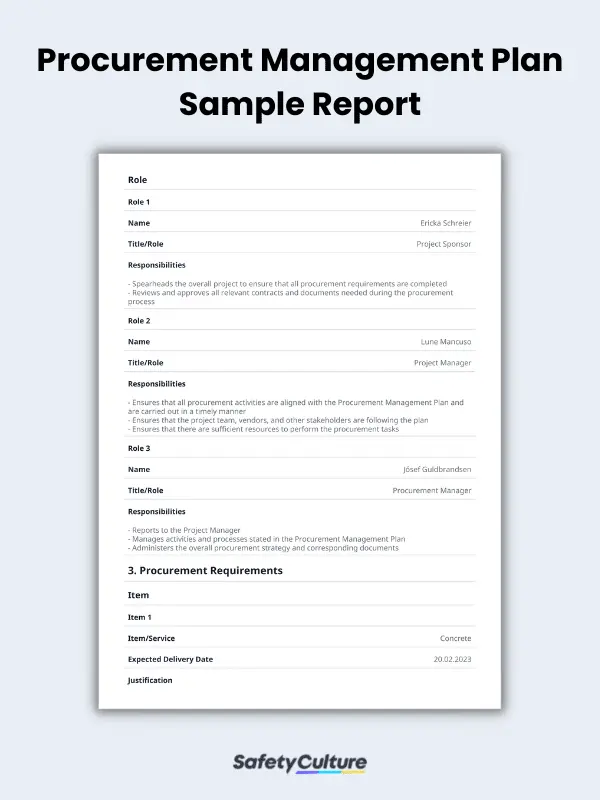What is a Procurement Management Plan?
A procurement management plan, also known as a procurement plan, is a document that lays out the process of acquiring goods and services from external sources. It is an essential tool for organizations to ensure that they are getting the best value for their money and that the goods and services to be purchased are of the highest quality. The plan also checks if the organization follows all applicable laws and regulations.
Purpose
A procurement management plan aims to establish a framework for obtaining products and services required in a project or business activity. It allows sourcing teams to lay out all essential details—including materials, contract types, schedules, and activities—before proceeding with the procurement process. Preparing this plan better equips organizations to streamline existing sourcing procedures and meet their procurement requirements on time and within budget.
Benefits
A procurement management plan offers plenty of benefits to an organization—from quality and compliance to cost-efficiency and timeliness. Here are 5 key advantages of using this plan:
Reduce Costs in Purchasing Products
Cost-effectiveness is one of the most important advantages of having a procurement plan. The organization is able to purchase the right goods and services at the right price since it has already planned out its procurement strategy before sourcing things.
This way, they can significantly lower the cost of items to be purchased without sacrificing their quality or efficiency.
Ensure the Quality of Sourced Materials
A procurement management plan can also help ensure that the organization is able to source materials and services from reliable suppliers by establishing quality control metrics before the supplier selection process. This practice reduces the risk of purchasing substandard goods.
Stay on Track with the Established Timeline and Budget
Time is of the essence in projects and business activities alike, and so are funds. And as a vital step before commencing operations, the procurement process must be carefully planned.
Developing a plan for handling the procurement process is also helpful for purchasing items in a timely manner and within the set budget. This ensures that the organization is able to not only meet its deadlines and objectives but also avoid overspending.
Promote Transparency in Procurement Practices
In order to facilitate a smooth-sailing sourcing process, organizations must be able to easily trace the items and services they procured throughout the supply chain.
A procurement plan is beneficial in this endeavor, as it lets them create an effective approach to documentation and reporting when purchasing goods. They can also use this tool to quickly run through their prospective suppliers so that they can lay the groundwork for a fair and equitable procurement process.
Comply with Laws and Standards
It’s a must for organizations to adhere to procurement laws and regulations within their place of operations. Creating a plan beforehand simplifies this process for them, as it outlines the steps they need to follow for compliance. This way, they are able to meet all legal requirements for sourcing materials and avoid delays or penalties that could set back their procurement goals.
What to Include in a Procurement Management Plan Template
Creating a procurement plan becomes more efficient with a ready-made template. When building a procurement management plan template for your sourcing efforts, here are the essential items to cover:
- Workflow and Activities – Lay out the tasks and activities required during the procurement process, along with their expected completion date and the people responsible for them.
- Roles and Responsibilities – Note the name and function of each person involved in procurement activities and include a description of their responsibilities.
- Procurement Requirements – Outline the materials and services to be procured. Then, provide details, such as the expected delivery dates, justification for sourcing the product or service, the contract type, and the type of procurement document required.
- Risk Management Strategy – Identify potential risks to the procurement process, rate their likelihood and impact, and devise ways to address them.
- Constraints and Assumptions – Discuss potential constraints and assumptions that the team needs to consider when carrying out the procurement efforts.
- Overlaps with Other Projects – Mention if there are other projects or business activities that can potentially impact the procurement process.
- List of Pre-Qualified Vendors – Create an initial list of potential suppliers, including their point person and contact information.
- Procurement Policy – Attach the procurement policy to be followed throughout the sourcing process.
FAQs about Procurement Management Plans
The 3Ps in procurement management stands for Paper, People, and Process. The Process component refers to the steps involved in the procurement process. Meanwhile, the People element pertains to the ones responsible for specific tasks in the sourcing system. Lastly, the Paper aspect covers the documents required when purchasing items and services.
Procurement systems come in three types:
- Traditional procurement system – involves the use of a centralized sourcing system, where all purchases are made through a single source.
- Decentralized procurement system – uses multiple sources for purchasing, allowing for greater flexibility and control over the purchasing process.
- Hybrid procurement system – combines elements of both traditional and decentralized sourcing systems for maximum efficiency when purchasing materials and services.
Some of the risks involved when creating and implementing procurement management plans include the following:
- Poorly managed plans can lead to delays in the procurement process, resulting in missed deadlines and increased costs.
- Failing to monitor the plan properly can lead to a lack of accountability and transparency in the procurement process. This, in turn, can result in fraud and corruption.
- If the plan is not properly implemented, organizations could fail to comply with laws and regulations, resulting in costly fines and penalties.




